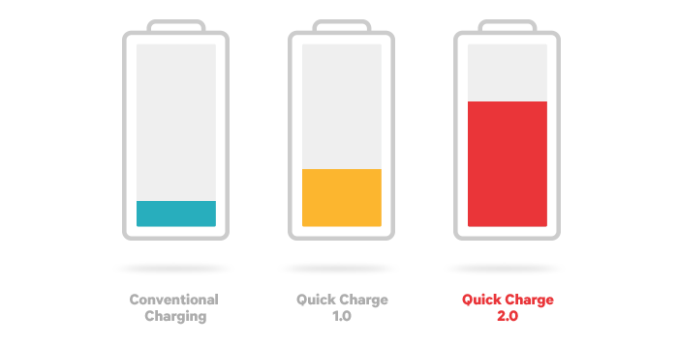Qualcomm Announces Quick Charge 3.0: Intelligent Voltage Control
by Joshua Ho on September 15, 2015 1:41 AM EST- Posted in
- Mobile
- Qualcomm
- SoCs
- Snapdragon 820
- Snapdragon 617
- Snapdragon 430

One of the other features that was announced for multiple Snapdragon SoCs at the 3G/LTE Summit in Hong Kong was Quick Charge 3.0, which will be supported on the Snapdragon 820, 617, and 430.
The latest iteration of Qualcomm's rapid charging technology, Quick Charge 3.0 is said to enable up to 27% faster charging over QC 2.0 or up to 38% more efficient. Relative to QC 1.0, charge speed doubles. This is done by using an algorithm that Qualcomm calls Intelligent Negotiation for Optimum Voltage, which allows for selection of appropriate voltage for various device states while charging. Rather than a number of fixed voltage settings, QC 3.0 can scale from 3.6 to 20V in 200 mV increments and will work over USB, including new connector designs like USB Type-C as the USB protocol is not the same as physical connector design. QC 3.0 will be available for vendors to implement now, and it’s likely that we’ll see phones with support for this new fast charging standard appear early next year.
Source: Qualcomm










27 Comments
View All Comments
name99 - Tuesday, September 15, 2015 - link
"One of the other features that was announced for multiple Snapdragon SoCs at the 3G/LTE Summit in Hong Kong was Quick Charge 3.0, which will be supported on the Snapdragon 820, 617, and 430."I think QC is being somewhat unclear here. Quick Charge is a QUALCOMM technology, not a SNAPDRAGON technology, isn't it?
Apple, for example, uses a QC PM controller that does everything described here (talk to the power brick to negotiate the voltage desired) and this works both within the Apple world (iPhone charges faster if you use the heftier iPad power brick) and using third party "Android" chargers.
It would be interesting (something for AnandTech to check...) to see if Apple is using a Quick Charge 3.0 PMIC in the iPhone 6S. When that's connected to a high power charger, maybe it'll charge faster than an iPhone6?
toyotabedzrock - Tuesday, September 15, 2015 - link
Why not just use two separate cells in the battery paired with a charge controller that can charge the cells in series and run the SOC with the cells in parallel.extide - Tuesday, September 15, 2015 - link
Why bother, why not just charge the cells in parallel? I mean you're not gaining anything doing it your way except making it complicated... Just a little buck converter to get the charging voltage and done.melgross - Tuesday, September 15, 2015 - link
No matter how these companies implement this, it's going to shorten the life of the battery. Lithium batteries are very sensitive to charge. It's been a problem from the beginning.JeffFlanagan - Tuesday, September 15, 2015 - link
As long as the battery lasts two years, most people will be fine with increased battery wear as a tradeoff for fast charging. Some of us will be fine with one year. Phone companies will replace the battery, and sell the phone used, when the phone is exchanged for a newer model.melgross - Tuesday, September 15, 2015 - link
The word "lasts" is elastic. Most phone batteries will hold a 70% charge after 2 years. What if that's 70% after one year?Inoperative - Sunday, September 20, 2015 - link
No, it's not impossible to implement fast charging capabilities without compromising on lifespan of the battery.Like Oppo did with VOOC, they put two Li-Po cells in parallel, and after my calculation that matches the per cell charge intensity you'd see with a single cell pack.
That's why I've been fond of VOOC, it works brilliantly in reality too, making it the fastest charging phone on the market.
It's nice to see Quick Charge 3.0 though, but unless they are using the same strategy of putting the cells in parallel, I totally agree that it's not very fortunate.
As far as I know the OEMs can to a greater extent tweak QC how they want, whereas VOOC being a more closely defined spec. I'd really like Oppo to make some effort in making the VOOC an open standard competing with QC, because as of now the VOOC charger is only good for Oppo devices.